Readiness of Regions for Digitalization of the Construction Complex
Abstract
:1. Introduction
2. Materials and Methods
2.1. Definitions and Research Methodology
- The expert builds a linguistic variable with its own term set of values (T). For example, for school: very low, low, medium, high, very high.
- To structurally describe the linguistic variable, the expert chooses its corresponding quantitative feature.
- The expert compares the function of belonging to a particular fuzzy subset for each value of a linguistic variable. Membership functions can be represented as piecewise linear functions, which are convenient to apply in practice since they have an analytical representation in the form of a mathematical function. These membership functions include triangular functions (I), trapezoidal functions (II), Z-shaped functions (III), and S-shaped functions (IV) (Table 1).
2.2. Method of Use
- Introducing the developed linguistic variable designating the “level of preparedness of the Russian region for the digitalization of the construction complex (Y)”; developing a scale for the assessment of the level of the proposed indicator.
- Selecting Xi factors for Yi groups. You need to create groups (orientation blocks) that affect the aggregated indicator being formed (see step 1). Next, you need to make a selection of those factors that serve as the basis of the orientation blocks 1-n.
- Determining the range of definition for the factors, sets of values, and triangular numbers. This means that factors are ranked by a triangular function in a given range. For example, if the ranking is based on a factor that determines the level of Gross regional product (GRP), then the values of this factor are filtered from a lower value to a higher value in accordance with the territory of the subject of the Federation. Next is the minimum, maximum, and average value. In accordance with the specified number of rating ranks, on the scale of fuzzy values of variables Y, formed according to step 1, the factor is normalized within the rank by T numbers. Therefore, the domain of determining the set of values and triangular numbers for this factor is formed.
- Normalizing Xi factors by group using the formula:
- Building a matrix of Xi factors after normalization by determining the level of their importance. Factors are classified according to Table 2.
- Calculating the aggregate indicator within each group (Y1, Y2, Y3, Y4). This indicator for each group is necessary for factor convolution, which will allow you to form aggregated indicators for groups (Y1, Y2, Y3, Y4). To calculate this indicator, the following formula is needed:where λij is determined from the table-matrix of factor values (Stage 5); yj refers to nodal points of triangular numbers, which are calculated using the formula:where j is the number of the column λ.
- Forming a single Y indicator using the weighting factors (ri) assigned to the formed groups. For the classification of the aggregated indicator for the groups, Table 3 is needed.
3. Results and Discussion
4. Conclusions
Author Contributions
Funding
Acknowledgments
Conflicts of Interest
Appendix A
References
- Russian Architecture and Construction Encyclopedia. Available online: http://gosstroy-vniintpi.ru/rase.htm (accessed on 20 May 2020).
- Kozlov, A.; Gutman, S.; Tereshko, E. Analysis of the Industry and Entrepreneurship component of the Murmansk region construction complex strategic chart. In E3S Web Conference; EDP Sciences: Ulis, France, 2019; Volume 91, p. 05011. [Google Scholar]
- David, O.; Russotto, F.-X.; Simoes, M.D.S.; Measson, Y. Collision avoidance, virtual guides and advanced supervisory control teleoperation techniques for high-tech construction: Framework design. Autom. Constr. 2014, 8, 63–72. [Google Scholar] [CrossRef]
- Cai, S.; Ma, Z.; Skibniewski, M.J.; Bao, S. Construction automation and robotics for high-rise buildings over the past decades: A comprehensive review. Adv. Eng. Inform. 2019, 10, 100989. [Google Scholar] [CrossRef]
- Wu, P.; Wang, J.; Wang, X. A critical review of the use of 3-D printing in the construction industry. Autom. Constr. 2016, 8, 21–31. [Google Scholar] [CrossRef] [Green Version]
- Strategy for the Development of the Information Society in the Russian Federation for 2017–2030, Approved by Presidential Decree No. 203 of 9 May 2017. Available online: https://www.prlib.ru/en/node/681488 (accessed on 25 July 2020).
- Digital Economy of the Russian Federation–Program Approved by the Order of the Government of the Russian Federation of 28 July 2017 1632-r. Available online: http://static.government.ru/media/files/9gFM4FHj4PsB79I5v7yLVuPgu4bvR7M0.pdf (accessed on 25 July 2020).
- Heigermoser, D.; de Soto, B.G.; Abbott, E.L.S.; Chua, D.K.H. BIM-based Last Planner System tool for improving construction project management. Autom. Constr. 2019, 104, 246–254. [Google Scholar] [CrossRef]
- Oraee, M.; Hosseini, M.R.; Edwards, D.J.; Li, H.; Papadonikolaki, E.; Cao, D. Collaboration barriers in BIM-based construction networks: A conceptual model. Int. J. Proj. Manag. 2019, 37, 839–854. [Google Scholar] [CrossRef]
- Al-Saeed, Y.; Edwards, D.J.; Scaysbrook, S. Automating construction manufacturing procedures using BIM digital objects (BDOs). Constr. Innov. 2020, 3, 345–377. [Google Scholar] [CrossRef]
- Chen, K.; Lu, W. Bridging BIM and building (BBB) for information management in construction. Eng. Constr. Archit. Manag. 2019, 7, 1518–1532. [Google Scholar] [CrossRef]
- Chan, D.W.; Olawumi, T.O.; Ho, A.M. Perceived benefits of and barriers to Building Information Modelling (BIM) implementation in construction: The case of Hong Kong. J. Build. Eng. 2019, 25, 100764. [Google Scholar] [CrossRef]
- Level of BIM Application in Russia in 2017. Research Report. Available online: http://concurator.ru/information/bim_report/ (accessed on 25 May 2020).
- Glukhov, A.P. Influence of resistance to digitalization on the diffusion of digital platform solutions. Tomsk State Univ. J. Econ. 2019, 48, 57–82. [Google Scholar] [CrossRef] [PubMed]
- Romanovich, M.; Ermakov, A.; Mukhamedzhanova, O. Scheduling on the basis of the research of dependences among the construction process parameters. In IOP Conference Series: Earth and Environmental Science [Electronic Resource]; IOP Publishing Ltd.: Bristol, UK, 2017; p. 012212. [Google Scholar] [CrossRef]
- Aziz, D.; Nawawi, A.H.; Ariff, R.M. ICT Evolution in Facilities Management (FM): Building Information Modelling (BIM) as the Latest Technology. Procedia Soc. Behav. Sci. 2016, 234, 363–371. [Google Scholar] [CrossRef] [Green Version]
- Dinga, L.Y.; Zhonga, B.T.; Wub, S.; Luoa, H.B. Construction risk knowledge management in BIM using ontology and semantic web technology. Saf. Sci. 2016, 87, 202–213. [Google Scholar] [CrossRef] [Green Version]
- Parka, J.W.; Chenb, J.; Choa, Y.K. Self-corrective knowledge-based hybrid tracking system using BIM and multimodal sensors. Adv. Eng. Inform. 2017, 32, 126–138. [Google Scholar] [CrossRef] [Green Version]
- Zoua, Y.; Kiviniemib, A.; Jonesa, S.W. A review of risk management through BIM and BIM-related technologies. Saf. Sci. 2016, 81, 78–83. [Google Scholar] [CrossRef]
- Valitova, I.; Trofimova, T.; Simankina, T.; Stein, E. Risk assessment related to the choice of contractors performing the job. In MATEC Web of Conferences Cep; International Science Conference SPbWOSCE-2017 Business Technologies for Sustainable Urban Development; EDP Sciences: Ulis, France, 2018; p. 01068. [Google Scholar]
- Pykhtin, K.; Simankina, T.; Sharmanov, V.; Kopytova, A. Risk-based approach in valuation of workplace injury rate for transportation and construction industry. In IOP Conference Series: Earth and Environmental Science; IOP Publishing Ltd.: Bristol, UK, 2017; Volume 90, p. 012065. [Google Scholar] [CrossRef] [Green Version]
- Sigalov, K.; Konig, M. Recognition of process patterns for BIM-based construction schedules. Adv. Eng. Inform. 2017, 31, 45–48. [Google Scholar] [CrossRef]
- Bradley, H.; Lark, R.; Dunn, S. BIM for infrastructure: An overall review and constructor perspective. Autom. Constr. 2016, 71, 139–152. [Google Scholar] [CrossRef]
- Wetzel, E.M.; Thabet, W.Y. The use of a BIM-based framework to support safe facility management processes. Autom. Constr. 2015, 60, 12–24. [Google Scholar] [CrossRef] [Green Version]
- Kang, T.W.; Hong, C.H. A study on software architecture for effective BIM/GIS-based facility management data integration. Autom. Constr. 2015, 54, 25–38. [Google Scholar] [CrossRef]
- Zhang, S.; Teizer, J.; Lee, J.-K.; Eastman, C.M.; Venugopal, M. Building Information Modeling (BIM) and Safety: Automatic Safety Checking of Construction Models and Schedules. Autom. Constr. 2013, 29, 183–195. [Google Scholar] [CrossRef]
- Benjaoran, V.; Bhokha, S. An integrated safety management with construction management using 4D CAD model. Saf. Sci. 2010, 48, 395–403. [Google Scholar] [CrossRef]
- Romanovich, M.A.; Sakhtereva, M.I. Specifics of creating digital twins of underground complexes (metro stations). In Proceedings of the BIM in Construction & Architecture Proceedings of III International Conference BIMAC 2020, Saint Petersburg, Russia, 28–30 October 2020; pp. 152–160. [Google Scholar]
- Vakhrusheva, S.; Martynenko, E.; Braila, N.; Kisel, T. Development of a cultural heritage object BIM model. In IOP Conference Series: Earth and Environmental Science; IOP Publishing Ltd.: Bristol, UK, 2017; Volume 90. [Google Scholar] [CrossRef]
- Romanovich, M.A.; Vsevolozhskaya, V.G.; Kuzminykh, A.R.; Popova, E.M.; Pertseva, A.E. Experience in creating a digital model of a building as part of the international educational program on the BIM 360 platform. In Proceedings of the BIM in Construction & Architecture Proceedings of III International Conference BIMAC 2020, Saint Petersburg, Russia, 28–30 October 2020; pp. 362–371. [Google Scholar]
- Balakina, A.; Simankina, T.; Lukinov, V. 4D modeling in high-rise construction. In E3S Web of Conferences; EDP Sciences: Ulis, France, 2018; Volume 33, p. 03044. [Google Scholar] [CrossRef]
- Sharmanov, V.V.; Simankina, T.L.; Mamaev, A.E. BIM in the assessment of labor protection. Mag. Civ. Eng. 2017, 1, 77–88. [Google Scholar]
- Afonasova, M.A.; Panfilova, E.E.; Galichkina, M.A.; Ślusarczyk, B. Digitalization in economy and innovation: The effect on social and economic processes. Pol. J. Manag. Stud. 2019, 2, 22–32. [Google Scholar]
- Bejtkovský, J.; Rózsa, Z.; Mulyaningsih, H.D. A phenomenon of digitalization and e-recruitment in business environment. Pol. J. Manag. Stud. 2018, 18, 58–68. [Google Scholar] [CrossRef]
- Succar, B.; Kassem, M. Macro-BIM adoption: Conceptual structures. Autom. Constr. 2015, 57, 64–79. [Google Scholar] [CrossRef] [Green Version]
- Kassem, M.; Succar, B. Macro-BIM adoption: Comparative market analysis. Autom. Constr. 2017, 81, 286–299. [Google Scholar] [CrossRef]
- Talapov, V.V. BIM Technology: The Essence and Features of Building Information Modeling Implementation; DMK Press: Moscow, Russia, 2015; p. 410. [Google Scholar]
- Google Trends. Analysis. Available online: https://trends.google.com (accessed on 29 May 2020).
- Zadeh, L.A. Fuzzy sets. Inf. Control 1965, 8, 338–353. [Google Scholar] [CrossRef] [Green Version]
- Klir, G.J.; Yuan, B. Fuzzy sets and fuzzy logic. In Theory and Applications; Prentice Hall: New York, NY, USA, 1995; 574p. [Google Scholar]
- Lee, K.H. First Course on Fuzzy Theory and Applications and Developments were Proposed; Springer: Berlin/Heidelberg, Germany, 2005; p. 336. [Google Scholar]
- Weimin, H.; Leping, S. Analysis of the Factors Influencing the Development of Regional Economy Based on Research into Rough Set and Entropy Theory. In Proceedings of the International Conference on Wireless Communications, Networking and Mobile Computing, WiCOM, Dalian, China, 12–14 October 2008; pp. 1–4. [Google Scholar]
- Baruah, H.K. The Theory of Fuzzy Sets: Beliefs and Realities. Int. J. Energy Inf. Commun. 2011, 2, 1–22. [Google Scholar]
- Reyna, V.F. A new intuitionism: Meaning, memory, and development in Fuzzy–Trace Theory. Judgm. Decis. Mak. 2012, 7, 332–359. [Google Scholar]
- Federal State Statistics Service. Russian Regions. Socio-Economic Indicators for 2019. Available online: https://gks.ru/bgd/regl/b19_14p/Main.htm (accessed on 22 May 2020).
- Digital Economy Indicators 2019. Statistical Bulletin. Available online: https://www.hse.ru/data/2019/06/25/1490054019/ice20/19.pdf (accessed on 20 May 2020).
- RIA Rating. Rating of Socio-Economic Situation in Regions–2018. Available online: https://riarating.ru/infografika/20180523/630091878.html (accessed on 22 May 2020).
- RIA Rating. Level of Development of Science and Technology in Russian Regions–2018. Available online: https://riarating.ru/infografika/20181017/630109152.html (accessed on 22 May 2020).
- Russian Regional Innovation Scoreboard. Issue 6. Available online: https://issek.hse.ru/mirror/pubs/share/315338500 (accessed on 22 May 2020).
- Rating of Innovative Regions of Russia—2017. Available online: http://i-regions.org/images/files/airr17.pdf (accessed on 22 May 2020).
- Human Development Index 2017. Analytical Center for the Government of the Russian Federation. Available online: https://ac.gov.ru/uploads/2-Publications/karta_HDI_2017.pdf (accessed on 20 May 2020).
- All-Russian Research. Digital Literacy Index 2017. Available online: https://ict.moscow/static/digital_educ.pdf (accessed on 22 May 2020).
- On Approval of the List of Cases in Which the Formation and Maintenance of an Information Model are Mandatory. Available online: http://http://docs.cntd.ru/document/563787932/ (accessed on 13 September 2020).
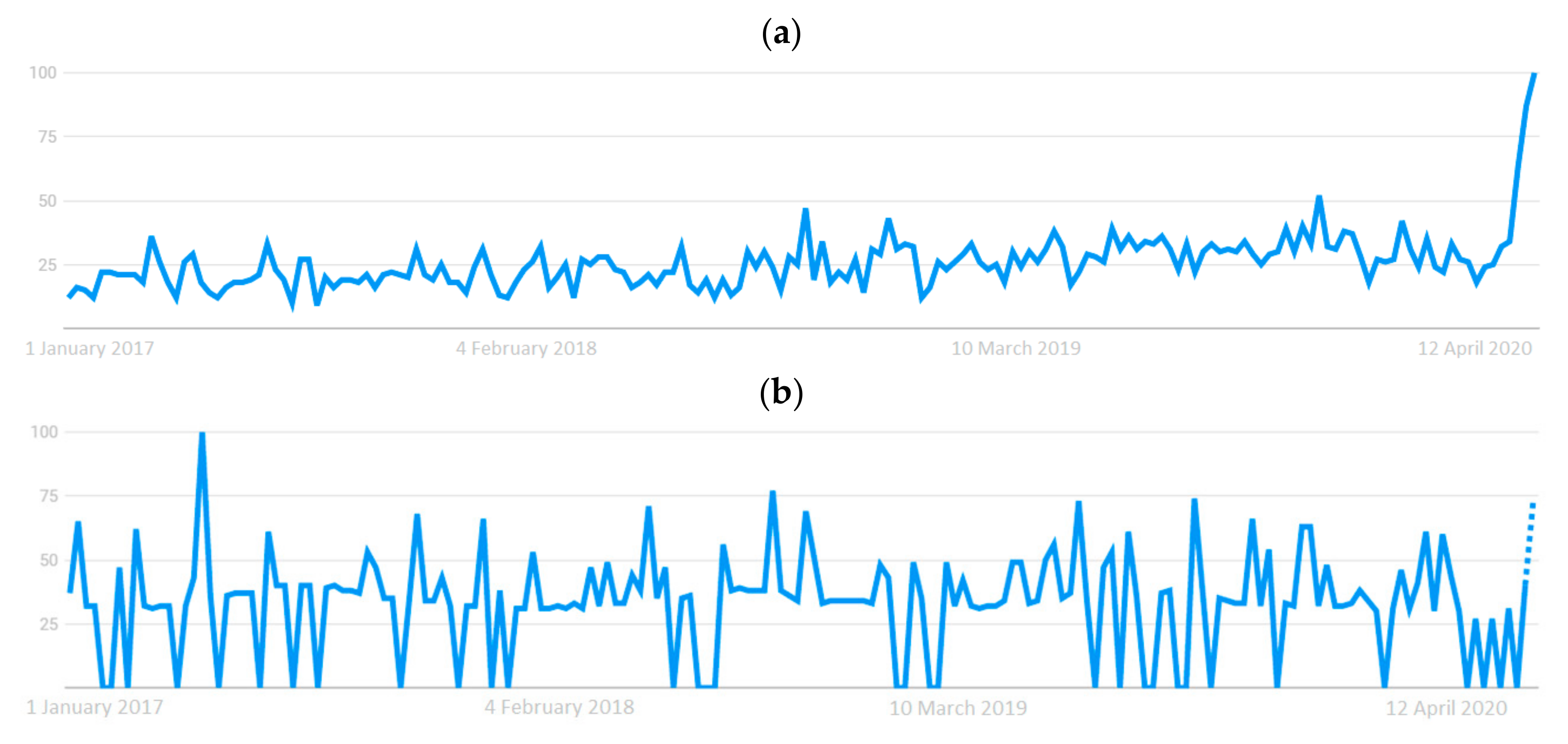
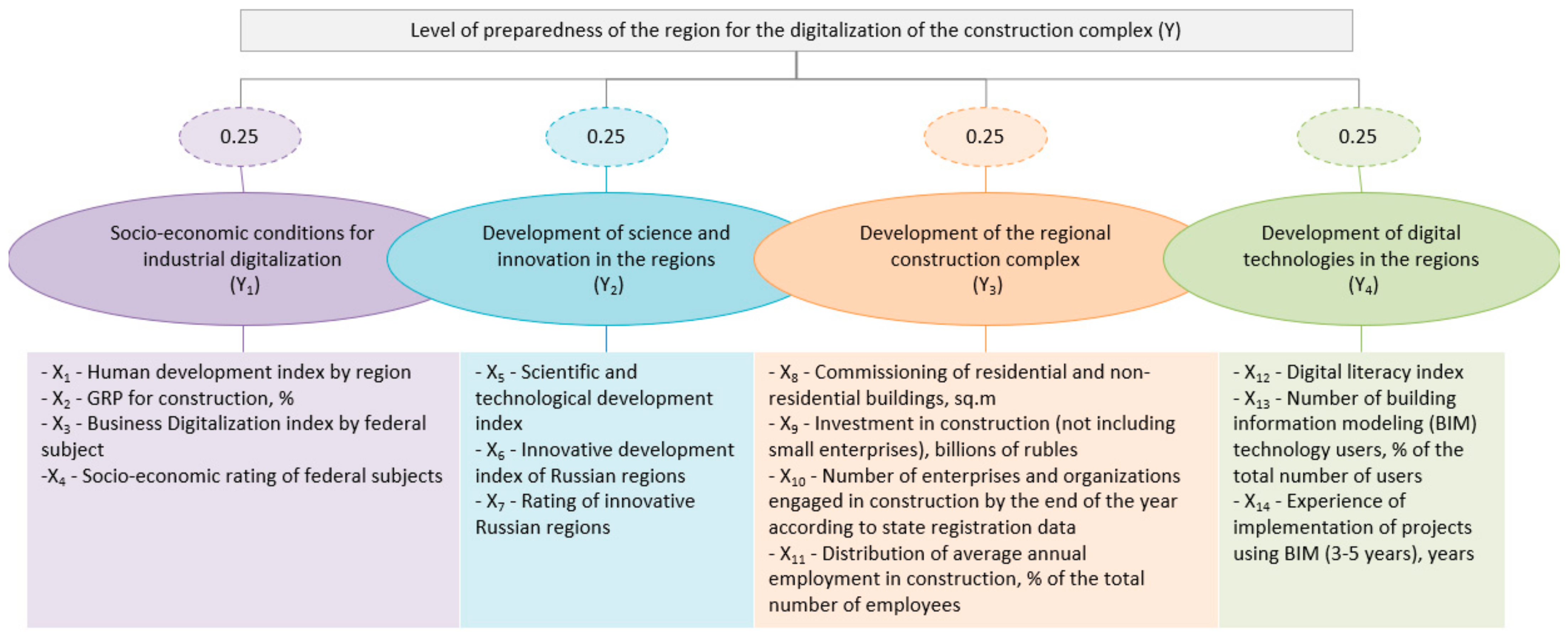



| Function Type | Function | Property |
|---|---|---|
| I | 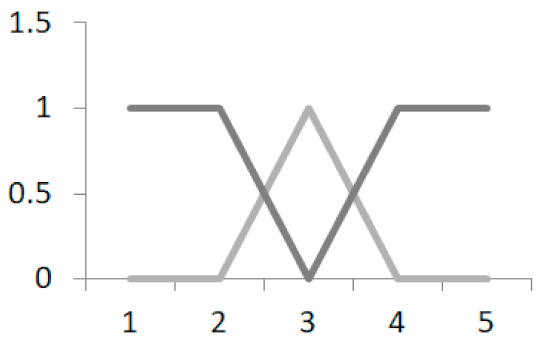 | where a, b, c are some numeric parameters that take arbitrary real values and are ordered by the relation . |
| II | 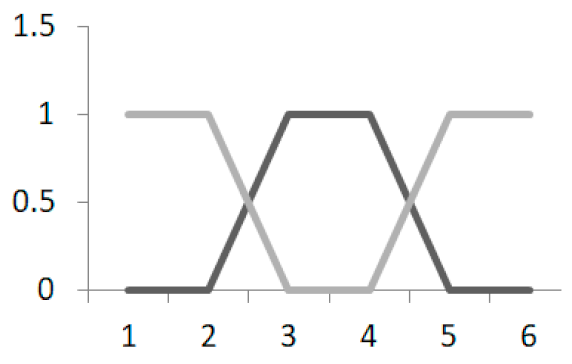 | where a, b, c, d are some numeric parameters that take arbitrary real values and are ordered by the relation . |
| III | 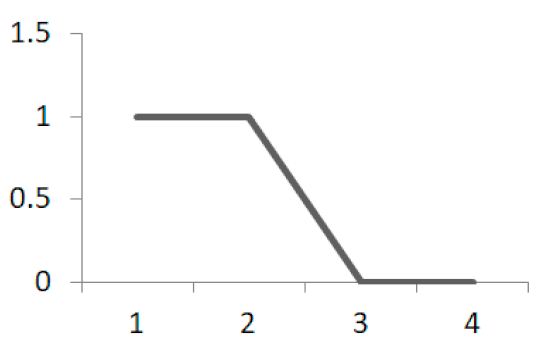 | where a and b are some numeric parameters that take arbitrary real values and are ordered by the relation . |
| IV | 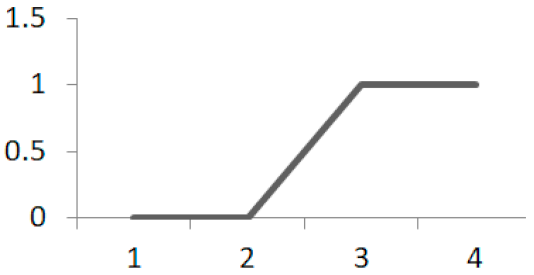 | where a and b are some numeric parameters that take arbitrary real values and are ordered by the relation . |
| Range of Y Values | Level Classification | Membership Function |
|---|---|---|
| −1.000 ≤ Xn ≤ −0.667 | X1 (very low) | 1 |
| −0.667 < Xn < −0.333 | X1 (very low) | |
| X2 (low) | ||
| −0.333 ≤ Xn < 0.000 | X2 (low) | |
| X3 (average) | ||
| 0.000 ≤ Xn < 0.333 | X3 (average) | |
| X4 (high) | ||
| 0.333 ≤ Xn < 0.667 | X4 (high) | |
| X5 (very high) | ||
| 0.667 ≤ Xn ≤ 1.000 | X5 (very high) | 1 |
| Range of Y Values | Level Classification | Membership Function |
| 0.000 ≤ Y ≤ −0.167 | Y1 (very low) | 1 |
| 0.167 < Y < 0.333 | Y1 (very low) | |
| Y2 (low) | ||
| 0.333 ≤ Y < 0.500 | Y2 (low) | |
| Y3 (average) | ||
| 0.500 ≤ Y < 0.667 | Y3 (average) | |
| Y4 (high) | ||
| 0.667 ≤ Y < 0.833 | Y4 (high) | |
| Y5 (very high) | ||
| 0.833 ≤ Y ≤ 1.000 | Y5 (very high) | 1 |
| No. | Set of Values | Level | Name |
|---|---|---|---|
| 1 | 0.000–0.333 | Very low | Weak preparedness of the region for digitalization of the construction complex, more than 50% lower than the Russian average. |
| 2 | 0.167–0.500 | Low | The region’s preparedness for digitalization of the construction complex is more than 25% lower than the Russian average. |
| 3 | 0.333–0.667 | Average | Average level of preparedness of the region for digitalization of the construction complex. |
| 4 | 0.500–0.833 | High | The region’s preparedness for digitalization of the construction complex is more than 25% higher than the Russian average. |
| 5 | 0.667–1.000 | Very high | High preparedness of the region for digitalization of the construction complex, more than 50% higher than the Russian average. |
| Scale | T Numbers | X1 | X2 | X3 | X4 |
|---|---|---|---|---|---|
| Very low | −1.000 | 0.80 | 1.90 | 18.00 | 85.00 |
| −0.667 | 0.83 | 4.27 | 20.83 | 71.00 | |
| −0.333 | 0.85 | 6.63 | 23.67 | 57.00 | |
| Low | −0.667 | 0.83 | 4.27 | 20.83 | 71.00 |
| −0.333 | 0.85 | 6.63 | 23.67 | 57.00 | |
| 0.000 | 0.88 | 9.00 | 26.50 | 43.00 | |
| Average | −0.333 | 0.85 | 6.63 | 23.67 | 57.00 |
| 0.000 | 0.88 | 9.00 | 26.50 | 43.00 | |
| 0.333 | 0.91 | 11.37 | 29.33 | 29.00 | |
| High | 0.000 | 0.88 | 9.00 | 26.50 | 43.00 |
| 0.333 | 0.91 | 11.37 | 29.33 | 29.00 | |
| 0.667 | 0.93 | 13.73 | 32.17 | 15.00 | |
| Very high | 0.333 | 0.91 | 11.37 | 29.33 | 29.00 |
| 0.667 | 0.93 | 13.73 | 32.17 | 15.00 | |
| 1.000 | 0.96 | 16.10 | 35.00 | 1.00 |
| Factor Name | Subset Scale | Level of Significance riY1 | ||||
|---|---|---|---|---|---|---|
| λ1(xi) | λ2(xi) | λ3(xi) | λ4(xi) | λ5(xi) | ||
| X1 | 0.405 | 0.595 | 0.250 | |||
| X2 | 0.250 | 0.750 | 0.250 | |||
| X3 | 0.132 | 0.868 | 0.250 | |||
| X4 | 1.000 | 0.250 | ||||
Publisher’s Note: MDPI stays neutral with regard to jurisdictional claims in published maps and institutional affiliations. |
© 2020 by the authors. Licensee MDPI, Basel, Switzerland. This article is an open access article distributed under the terms and conditions of the Creative Commons Attribution (CC BY) license (http://creativecommons.org/licenses/by/4.0/).
Share and Cite
Tereshko, E.; Romanovich, M.; Rudskaya, I. Readiness of Regions for Digitalization of the Construction Complex. J. Open Innov. Technol. Mark. Complex. 2021, 7, 2. https://doi.org/10.3390/joitmc7010002
Tereshko E, Romanovich M, Rudskaya I. Readiness of Regions for Digitalization of the Construction Complex. Journal of Open Innovation: Technology, Market, and Complexity. 2021; 7(1):2. https://doi.org/10.3390/joitmc7010002
Chicago/Turabian StyleTereshko, Ekaterina, Marina Romanovich, and Irina Rudskaya. 2021. "Readiness of Regions for Digitalization of the Construction Complex" Journal of Open Innovation: Technology, Market, and Complexity 7, no. 1: 2. https://doi.org/10.3390/joitmc7010002
APA StyleTereshko, E., Romanovich, M., & Rudskaya, I. (2021). Readiness of Regions for Digitalization of the Construction Complex. Journal of Open Innovation: Technology, Market, and Complexity, 7(1), 2. https://doi.org/10.3390/joitmc7010002





